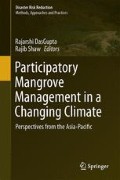Abstract
Mangrove forest plays a crucial role in protecting coastal areas, maintaining marine ecosystems, and retaining local community livelihoods. Over the last few decades, however, mangrove resource has gradually declined in conjunction with human activities and climate pressure. In response to the problem, Cambodian government has promoted Participatory Management of Mangrove Resource (PMMR) through increasing involvement of relevant stakeholders. This chapter analyzes both opportunities and challenges for PMMR in Cambodia. It is found that the supports from government and development agencies, commitment and participation of local communities, and connectivity of mangrove resources to the sustainable marine resource management are the key opportunities for promoting effective PMMR. Unbalancing between coastal development and costal resource conservation, lack of policy/law to support community-based mangrove resource management, insufficient resources, limited community empowerment, limited mechanism for monitoring and evaluation of the impacts, poor knowledge on importance of mangrove and managerial skills, and limited coordination remains the key barriers for enhancing the effectiveness of PMMR. It was recommended that the effective PMMR can be realized through (1) establishing specific policy legislation focusing particularly on mangrove resources protection, (2) enhancing coordination and collaboration between all relevant actors, (3) empowering local community, and (4) continuing raising awareness among communities on the importance of mangrove forest and involving to actively engage in the process and activities of sustainable marine resources management and conservation. By fulfilling these key strategic interventions, the pragmatic system and institutional setup are more feasible in order to drive reform for the betterment of PMMR in Cambodia.
Access this chapter
Tax calculation will be finalised at checkout
Purchases are for personal use only
References
ActionAid (2009) Enhanced food and social security for coastal fisher folks and their families
Bann C (1997) An economic analysis of alternative mangrove management strategies in Koh Kong Province, Cambodia. International Development Research Centre, Ottawa
Bobenrieth M, Sun K (2012) Vulnerability and capacity assessment of Koh Kong and Kampot provinces, Cambodia. IUCN, Gland
Brian K, Kong K, Sun K, Supanuth C, Ney P, Oul R (n.d.) Study of coastal mangrove forest devastation and channel sedimentation: community-based solutions Koh Kong Province, Cambodia. The International Union for Conservation of Nature (IUCN), Gland
CCCA (2012) Assessment of coping strategies in the Coastal Zone of Cambodia. Cambodia Climate Change Allience, Phnom Penh
Datta D, Chattopadhyay R, Guha P (2012) Community based mangrove management: a review on status and sustainability. J Environ Manag 107:84–95
FAO (2005) Global forest resources assessment 2005: thematic study on mangroves Cambodia. Food and Agriculture Organisation, Rome
IMM, CFDO, & CBNRM LI (2005) Understanding the Factors that Support or Inhibit Livelihood Diversification in Coastal Cambodia. An output from DFID-funded research in Cambodia, UK
IUCN (n.d.) Zoning Proposal for Peam Krasop Wildlife Sanctuary Koh Kong Province, Cambodia
Marschke M, Nong K (2003) Adaptive co-management: lessons from coastal Cambodia. Can J Dev Stud/Revue canadienne d’études du développement 24(3):369–383
Marschke M, Sinclair AJ (2009) Learning for sustainability: participatory resource management in Cambodian fishing villages. J Environ Manag 90(1):206–216
MoE (2002) State of environment report Kampot Province, Kampot Working Group. Ministry of Environment, Phnom Penh
MoE (2013a) 3rd state of the coastal environment, climate change and socio-economy report 2013. Ministry of Environment, Phnom Penh
MoE (2013b) National strategy and action plan 2014–2016: mangrove for the future. Cambodia Ministry of Environment, Phnom Penh
Nasuchon N (2009). Coastal management and community management in Malaysia, Vietnam, Cambodia and Thailand, with a case study of Thai fisheries management. Division for Ocean Affairs and the Law of the Sea, Office of Legal Affairs, the United Nations, New York
RGC (2012) Country environment profile. European Union Deligation to Cambodia, Phnom Penh
Rizvi AR, Singer U (2011) Cambodia coastal situation analysis. International Union for Conservation of Nature and Natural Resources (IUCN), Gland, p 58
Sunderlin WD (2006) Poverty alleviation through community forestry in Cambodia, Laos, and Vietnam: an assessment of the potential. Forest Policy Econ 8(4):386–396
UNEP, & CUAS (2015) Unit 4. Background materials to the MOOC: disasters and ecosystems: resilience in a changing climate. United Nations Environmental Programme and Cologne University of Applied Sciences, Geneva/Cologne
WWF (2015) Mangrove importance. Retrieved 9 September 2015, from http://wwf.panda.org/about_our_earth/blue_planet/coasts/mangroves/mangrove_importance/
Author information
Authors and Affiliations
Corresponding author
Editor information
Editors and Affiliations
Rights and permissions
Copyright information
© 2017 Springer Japan KK
About this chapter
Cite this chapter
Nop, S., DasGupta, R., Shaw, R. (2017). Opportunities and Challenges for Participatory Management of Mangrove Resource (PMMR) in Cambodia. In: DasGupta, R., Shaw, R. (eds) Participatory Mangrove Management in a Changing Climate. Disaster Risk Reduction. Springer, Tokyo. https://doi.org/10.1007/978-4-431-56481-2_12
Download citation
DOI: https://doi.org/10.1007/978-4-431-56481-2_12
Published:
Publisher Name: Springer, Tokyo
Print ISBN: 978-4-431-56479-9
Online ISBN: 978-4-431-56481-2
eBook Packages: Earth and Environmental ScienceEarth and Environmental Science (R0)

